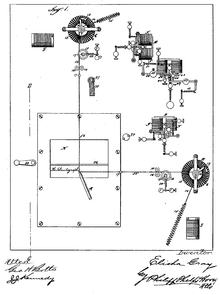Telautograph

The telautograph, an analog precursor to the modern fax machine, transmits electrical impulses recorded by potentiometers at the sending station to servomechanisms attached to a pen at the receiving station, thus reproducing at the receiving station a drawing or signature made by the sender. It was the first such device to transmit drawings to a stationary sheet of paper; previous inventions in Europe had used rotating drums to make such transmissions.
The telautograph's invention is attributed to Elisha Gray, who patented it on July 31, 1888. Gray's patent stated that the telautograph would allow "one to transmit his own handwriting to a distant point over a two-wire circuit." It was the first facsimile machine in which the stylus was controlled by horizontal and vertical bars.[1] The telautograph was first publicly exhibited at the 1893 World's Columbian Exposition held in Chicago.

In an 1888 interview in The Manufacturer & Builder (Vol. 24: No. 4: pages 85–86) Gray made this statement:[2]
By my invention you can sit down in your office in Chicago, take a pencil in your hand, write a message to me, and as your pencil moves, a pencil here in my laboratory moves simultaneously, and forms the same letters and words in the same way. What you write in Chicago is instantly reproduced here in fac-simile. You may write in any language, use a code or cipher, no matter, a fac-simile is produced here. If you want to draw a picture it is the same, the picture is reproduced here. The artist of your newspaper can, by this device, telegraph his pictures of a railway wreck or other occurrences just as a reporter telegraphs his description in words.

By the end of the 19th century, the telautograph was modified by Foster Ritchie. Calling it the telewriter, Ritchie's version of the telautograph could be operated using a telephone line for simultaneous copying and speaking.[1]
The telautograph became very popular for the transmission of signatures over a distance, and in banks and large hospitals to ensure that doctors' orders and patient information were transmitted quickly and accurately. Teleautograph systems were installed in a number of major railroad stations to relay hand-written reports of train movements from the interlocking tower to various parts of the station.[3][4] The teleautograph network in Grand Central Terminal included a public display in the main concourse into the 1960s; a similar setup in Chicago Union Station remained in operation into the 1970s.

An example of a Telautograph machine writing script can be seen in the 1956 movie Earth vs the Flying Saucers as the output device for the mechanical translator. A Telautograph was used in 1911 to warn workers on the 10th floor about the Triangle Shirtwaist Factory fire that had broken out two floors below.
Telautograph Corporation changed its name several times. In 1971, it was acquired by Arden/Mayfair. In 1993, Danka Industries purchased the company and renamed it Danka/Omnifax. In 1999, Xerox corporation purchased the company and called it the Omnifax division, which has since been absorbed by the corporation.
References
- 1 2 The worldwide history of telecommunications. Wiley-IEEE.
- ↑ "Elisha Gray Deserves Top Billing In Brownsville History". Glenn Tunney.
- ↑ Chicago, Illinois. Reading the teleautograph in the trainmaster's office of the Union Station. The messages originate in the interlocking tower and are carried to teleautographs in various parts of the station; the trainmaster's office, the passenger agent's office, information desk, etc., photograph by Jack Delano, Feb. 1943 Feb., Farm Security Administration - Office of War Information Photograph Collection (Library of Congress).
- ↑ Walter J. Armstrong, Mechanical and Electrical Equipment of the Toronto Union Station, Journal of the Engineering Institute of Canada, Vol. 4 (1921); pages 87-97, see particularly page 95.
External links
- Archive of Xerox Omnifax Division website, the successor to Telautograph Corporation.
- Telautograph historical description
Patents
Patent images in TIFF format
- U.S. Patent 0,386,814 Art of Telegraphy, issued July 1888 (first telautograph patent)
- U.S. Patent 0,386,815 Telautograph, issued July 1888
- U.S. Patent 0,461,470Telautograph, issued October 1891
- U.S. Patent 0,461,472 Art of and Apparatus for Telautographic Communication, issued October 1891 (improved speed and accuracy)
- U.S. Patent 0,491,347 Telautograph, issued February 1893
- U.S. Patent 0,494,562 Telautograph, issued April 1893